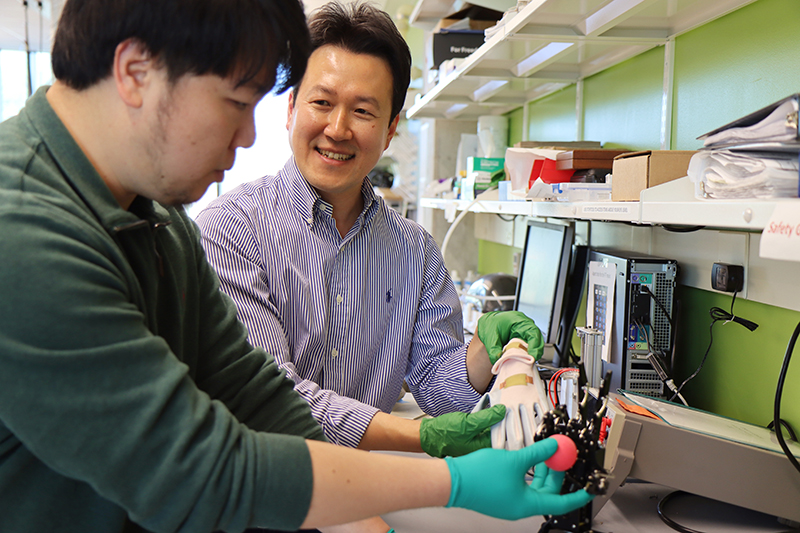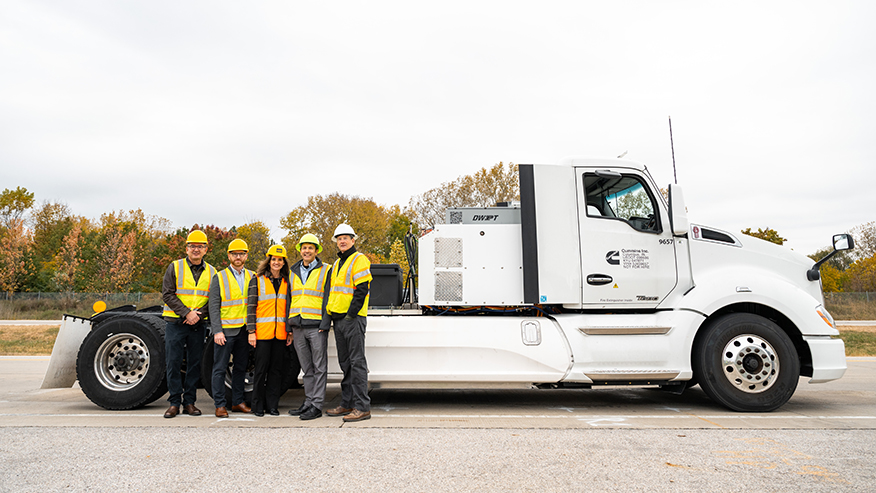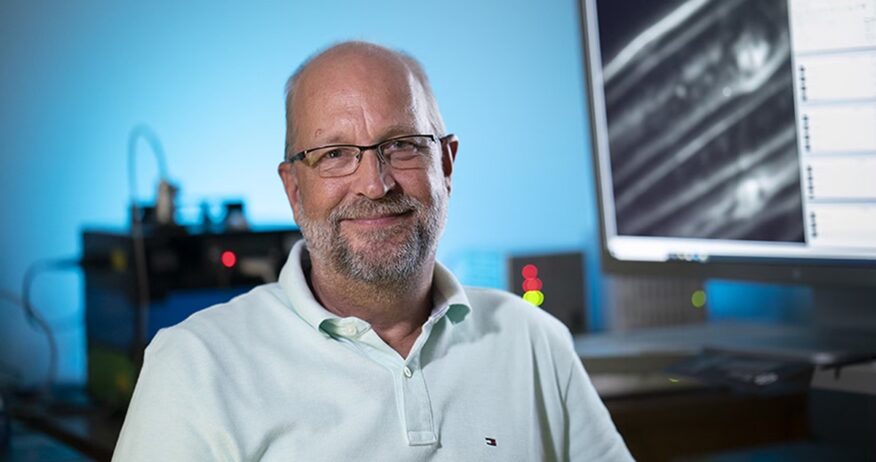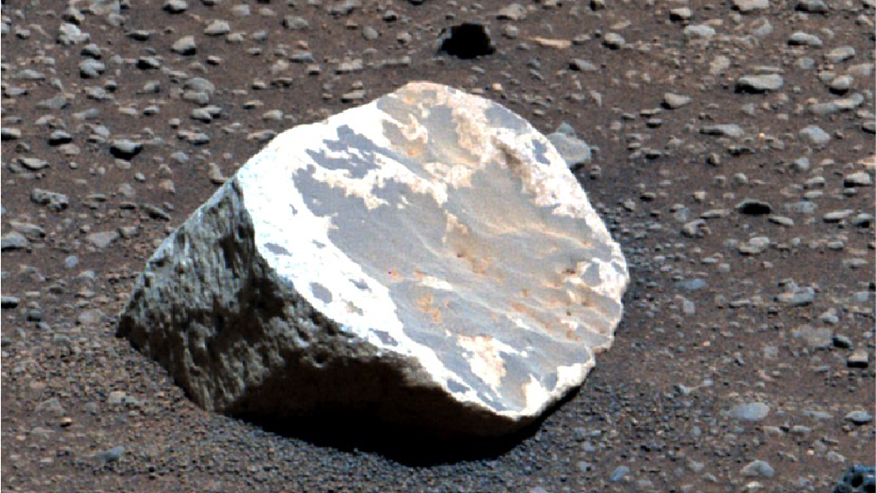Purdue researchers fabricate sensors with potential health-monitoring applications onto ready-made wearables
Patent-pending technique creates sensors that demonstrate high flexibility and strain sensitivity but don’t affect breathability

Using a robotic hand, Jinwook Baek (left), postdoctoral research assistant, and Sunghwan Lee, assistant professor of engineering technology at Purdue, examine how a flexible and wearable sensor could be used to monitor health information and manipulate a small object. (Purdue University photo/John O’Malley)
WEST LAFAYETTE, Ind. —
A patent-pending method developed by Purdue University researchers brings the public one step closer to clothes with wearable electronics that don’t affect the wearer’s comfort. The method also simplifies the manufacturing process and boosts sensing capability.
Wearable electronics that monitor bioinformation like blood pressure, body temperature and respiratory patterns have become prominent in research. Traditional wearable devices such as health-monitoring systems, however, are hard and inflexible, which makes them difficult to wear for extended periods of time.
Furthermore, fabricating wearable sensors onto clothing creates different sets of problems, said Sunghwan Lee, assistant professor of engineering technology in the Purdue Polytechnic Institute. Traditional sensors eliminate fabric breathability, or the circulation of air from the inside to the outside. Breathability allows vapor moisture to diffuse, which prevents people from overheating and keeps them comfortable.
“This is significant especially when sensors have military or medical assistive rehabilitation applications,” Lee said. “People need to wear these electronics for long periods of time. It isn’t convenient to replace them in the middle of a rehab session or military exercise.
“These limitations are caused by the traditional method to fabricate sensors on clothing. It relies on either brittle and inflexible inorganic materials, which lack longer-cycle stability, or liquid-phase processing, which is unable to create conformal coating on fabrics and hence makes it difficult to secure the required breathability.”
Lee and his team have used a technique called oxidative chemical vapor deposition, or oCVD, to form highly conducting and mechanically flexible polymer films conformally coated on every thread of fabric. It controls the thickness of the polymer layer, called PEDOT, while maintaining the fabric’s breathability and flexibility.
Lee and his team demonstrated the method by directly depositing and patterning the PEDOT layer on commercially available disposable gloves and masks to create blood pressure- and respiratory rate-monitoring sensors. The team confirmed the mechanical flexibility of the conformally vapor-printed PEDOT layer through cyclic bending tests on fabric samples coated with various thicknesses of the films at different temperatures.

“Samples were bent 180 degrees to generate high stress and strain on the fabrics. Their electrical conductivity was measured every cycle,” Lee said. “The deposited layer was shown to maintain its conductive performance consistently for more than 100 bending cycles. This exemplifies excellent mechanical flexibility and resilience to bending and strain that typical wearable fabrics undergo.”
A breathability test determined that the fabric’s air permeability was not compromised by the coated PEDOT film. There was a negligible difference in breathability between bare fabric and an oCVD PEDOT-coated fabric; there also was no clear difference between oCVD PEDOT-coated fabrics of varying thicknesses.
“This consistent high breathability indicates the enhanced versatility of oCVD PEDOT for wearable devices, as film thickness can be adjusted per application without having to consider the effect on breathability,” Lee said.
A manuscript about Lee’s research was published in the October 2021 issue of the peer-reviewed journal Science Advances. He disclosed the innovation to the Purdue Research Foundation Office of Technology Commercialization, which has applied for patent protection on the intellectual property. Industry partners interested in further developing the technology for the marketplace should contact Will Buchanan, wdbuchanan@prf.org, about 2021-LEE-69500.
Lee said the next steps to develop the process are packaging and pairing through Bluetooth to wirelessly monitor health information during everyday activities without a medical expert’s assistance.
Lee’s research was supported by the Purdue Polytechnic Institute’s Realizing the Digital Enterprise program.
About Purdue University
Purdue University is a public research institution with excellence at scale. Ranked among top 10 public universities (Times Higher Education/Wall Street Journal and QS), with two colleges in the top 4 in the United States (U.S. News & World Report), Purdue discovers and disseminates knowledge with a quality and at a scale second to none. More than 105,000 students study at Purdue across modalities and locations, with 50,000 in person on the West Lafayette campus. Committed to affordability and accessibility, Purdue’s main campus has frozen tuition 12 years in a row. See how Purdue never stops in the persistent pursuit of the next giant leap, including its first comprehensive urban campus in Indianapolis, the new Mitchell E. Daniels, Jr. School of Business, and Purdue Innovates, at https://stories.purdue.edu.
About Purdue Research Foundation Office of Technology Commercialization
The Purdue Research Foundation Office of Technology Commercialization operates one of the most comprehensive technology transfer programs among leading research universities in the U.S. Services provided by this office support the economic development initiatives of Purdue University and benefit the university’s academic activities through commercializing, licensing and protecting Purdue intellectual property. In fiscal year 2022, the office reported 157 deals finalized with 237 technologies signed, 379 disclosures received and 169 issued U.S. patents. The office is managed by the Purdue Research Foundation, which received the 2019 Innovation and Economic Prosperity Universities Award for Place from the Association of Public and Land-grant Universities. In 2020, IPWatchdog Institute ranked Purdue third nationally in startup creation and in the top 20 for patents. The Purdue Research Foundation is a private, nonprofit foundation created to advance the mission of Purdue University. Contact otcip@prf.org for more information.
Writer/Media Contact: Steve Martin, sgmartin@prf.org
Source: Sunghwan Lee, sunghlee@purdue.edu



